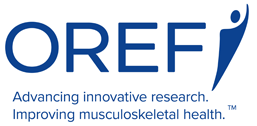

Stephanie Russo, MD, PhD
OREF/ORS Resident Research Project Grant
Research Topic
Better understanding of therapeutic taping as a treatment intervention for children with brachial plexus birth palsy
Patient Impact
For patients with brachial plexus birth palsy interested in reducing scapular winging by therapeutic taping, facilitating the middle and lower trapezius (back) muscles is the most effective method
Helping Children with Brachial Plexus Birth Palsy
ORS/OREF grant recipient seeks to optimize therapeutic taping
Sharon Johnson, OREF contributing writer
Brachial Plexus Birth Palsy (BPBP), an injury to upper extremity nerves, occurs during childbirth. Approximately one out of every 1,000 children born will have deficits to their upper extremity from BPBP, such as scapular winging. Deficits can include varying degrees of paralysis of the arm and altered shoulder function.1-3
“Kids with BPBP frequently complain about scapular winging,” explained Stephanie Russo, MD, PhD, affiliated assistant professor, kinesiology & applied physiology in the Biomechanics and Movement Science Department of the University of Delaware. “They don’t like the way it looks, and it makes it difficult for them to dress. For example, straps often fall off their shoulders.”
Scapular winging, a protrusion of the shoulder blade away from the chest wall, occurs frequently in patients with BPBP. Therapeutic taping has become the standard protocol for treating scapular winging; however, there is little data demonstrating the efficacy of and standards for the procedure.
While an orthopaedic surgery resident at University of Pittsburgh Medical Center (UPMC) Hamot, Erie, Pa., Dr. Russo secured a Resident Research Project Grant co-funded by the Orthopaedic Research Society (ORS) and the Orthopaedic Research and Education Foundation (OREF). The grant supported a one-year investigation to improve understanding of shoulder function and determine which, if any, of three different therapeutic taping methods is the most effective application for scapular stabilization in children with BPBP.
Which taping method is best?
Dr. Russo assembled a multidisciplinary research team from Philadelphia Shriners Hospital for Children and Erie Shriners Hospital for Children. Team members brought to the project expertise in orthopaedic surgery, biomechanics, and physical and occupational therapy.
The team recruited study participants from the two hospitals. On each of the 28 children participating, researchers applied three taping constructs:
- facilitation of middle and lower trapezius muscles,
- facilitation of rhomboid major and minor muscles, and
- facilitation of combined trapezius and rhomboid muscles.
Using motion-capture technology, the research team took three-dimensional measurements of participants with each taping construct applied while their arms were in four positions: 1)arms at rest (neutral position) and arms reaching three ways: 2)toward their mouths (a modified Mallet position), 3)toward opposite shoulders (cross-body adduction), and 4) toward their bellies (internal rotation). As a control, each participant was also measured in these positions without any taping.
Dr. Russo and her research team found that rhomboids taping had no effect when compared to no taping, but trapezius and combined taping constructs significantly decreased scapular winging in all arm positions. However, they found that combined taping limited humerothoracic cross-body adduction. They also noted that the clinical change for either effective taping configuration was small and long-term benefits still unknown, concluding that other factors, such as time, potential for skin irritation and patient motivation should be considered before applying therapeutic tape. For BPBP patients who do want to pursue therapeutic taping for scapular winging, Dr. Russo and her team believe that facilitation of the middle and lower trapezius muscles will be the most effective configuration. These results were published in The American Journal of Occupational Therapy in August 20164 and in the Journal of Hand Therapy in July of 2018.5
Broader implications
Dr. Russo and her colleagues are still learning from and building on the research funded by the ORS/OREF grant. Their findings have opened the door to further studies with broader implications.
“There’s a prevailing theory that internal rotation contracture is what causes shoulder joint pathology in children with BPBP. Our line of research, along with that of a couple of other groups, is starting to show that that’s not the whole picture. Results suggest shoulder joint pathology is tied to multidirectional joint contracture,” Dr. Russo said.
On another front, Dr. Russo said, the lack of accurate measures for evaluating scapular orientation is an ongoing challenge for clinicians treating scapular winging and other conditions related to BPBP. Functional assessments that orthopaedists rely on to monitor patients’ progress following treatment provide scant data as to specific joint motions.
Researchers have a similar problem, Dr. Russo explained. Motion-capture technology has been an important tool for studying gait mechanics and other contributors to lower extremity functionality. However, the technology has been less able to accurately describe the complex kinematics of the shoulder and analyze the pathologies of the upper extremities. Dr. Russo hopes the results of her study will provide some insights as to how to bridge such knowledge gaps and formulate relevant paths of inquiry for future research.
Helping parents manage their stress
In most cases, Dr. Russo has found that brachial plexus birth palsy is also very stressful for parents.
“It’s normal to go through a grieving period when your child is born with a difference of any kind. It’s called grieving the loss of a normal child. It probably takes parents time to come to terms with it,” Dr. Russo said.
Still, as Dr. Russo explained, patients’ parents often don’t feel entitled to grieve. Their children are, generally speaking, quite healthy while other families struggle to manage serious, sometimes fatal pediatric problems. This leaves Dr. Russo’s patients’ parents feeling guilty about feeling bad for their kids.
Enthusiastic participants, encouraging results
From the children’s side of the bench, Dr. Russo said the research was fun and empowering—an opportunity for patients to participate in their own care. “The kids liked it a lot. They got to see themselves up on a computer. They were very enthusiastic about participating in research,” Dr. Russo said.
One patient who participated in another project of Dr. Russo’s came to a clinical appointment with videos documenting her progress following surgery. “She was showing us all these videos of everything she could do now that she couldn’t do before—like going across monkey bars, and a freestyle stroke at swimming lessons. Then, as we were about to leave the room, she told us, ‘my teacher asked me what I want to be when I grow up and I told her I want to be a surgeon because my surgeon inspires me.’ To me, that’s what makes everything worthwhile.”
Dr. Russo and her team are enthusiastic that their work is improving quality of life for patients. “We’ve learned a lot about the injury and made some changes as to how we’re managing their care from our research. So, it’s really neat to be able to see changes in a relatively short amount of time,” Dr. Russo said.
Research that makes a difference
Dr. Russo described the ORS/OREF grant as “very important” to the team’s work, to her progress toward achieving her goals as a clinician scientist, and to making a difference in patients’ lives.
“It’s great to see the patients on return visits and be able to improve their treatment. The holy grail is trying to make our treatment the best that it can be,” Dr. Russo said.
References
1. Hogendoorn, S., K.L. van Overvest, I. Watt, A.H. Duijsens, and R.G. Nelissen, Structural changes in muscle and glenohumeral joint deformity in neonatal brachial plexus palsy. J Bone Joint Surg Am, 2010. 92(4): p. 935-42.
2. Hoeksma, A.F., H. Wolf, and S.L. Oei, Obstetrical brachial plexus injuries: incidence, natural course and shoulder contracture. Clin Rehabil, 2000. 14(5): p. 523-6.
3. Adler, J.B. and R.L. Patterson, Jr., Erb's palsy. Long-term results of treatment in eighty-eight cases. J Bone Joint Surg Am, 1967. 49(6): p. 1052-64.
4. Russo SA, Rodriguez LM, Kozin SH, Zlotolow DA, Chafetz RS, Killelea CM, Nicholson KF, Richards JG. Therapeutic Taping for Scapular Stabilization in Children With Brachial Plexus Birth Palsy. Am J Occup Ther. 2016 Sep-Oct;70(5):7005220030p1-7005220030p11. doi: 10.5014/ajot.2016.018903. PubMed PMID: 27548867.
5. Russo SA, Zlotolow DA, Chafetz RS, Rodriguez LM, Kelly D, Linamen H, Richards JG, Lubahn JD, Kozin SH. Efficacy of 3 therapeutic taping configurations for children with brachial plexus birth palsy. J Hand Ther. 2018 Jul - Sep;31(3):357-370. doi: 10.1016/j.jht.2017.03.001. Epub 2017 Apr 25. PMID: 28454773
